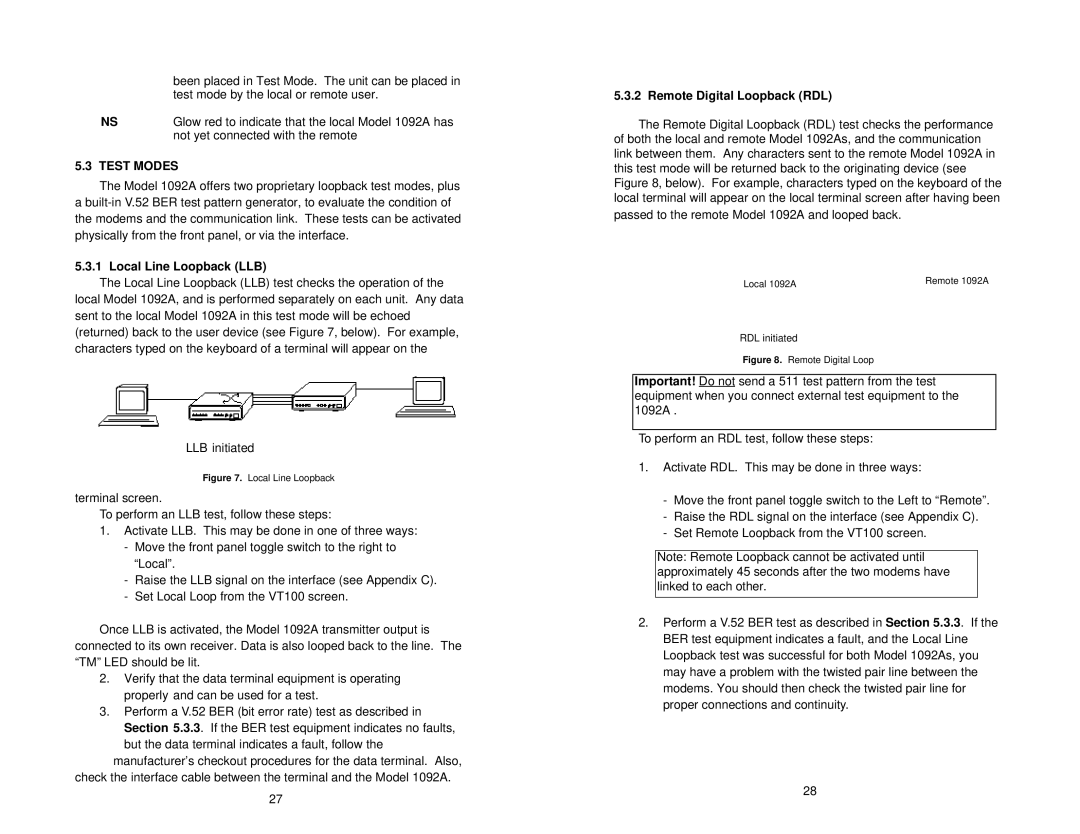
| been placed in Test Mode. The unit can be placed in |
| test mode by the local or remote user. |
NS | Glow red to indicate that the local Model 1092A has |
| not yet connected with the remote |
5.3 TEST MODES
The Model 1092A offers two proprietary loopback test modes, plus a
5.3.1 Local Line Loopback (LLB)
The Local Line Loopback (LLB) test checks the operation of the local Model 1092A, and is performed separately on each unit. Any data sent to the local Model 1092A in this test mode will be echoed (returned) back to the user device (see Figure 7, below). For example, characters typed on the keyboard of a terminal will appear on the
LLB initiated
Figure 7. Local Line Loopback
terminal screen.
To perform an LLB test, follow these steps:
1.Activate LLB. This may be done in one of three ways:
-Move the front panel toggle switch to the right to “Local”.
-Raise the LLB signal on the interface (see Appendix C).
-Set Local Loop from the VT100 screen.
Once LLB is activated, the Model 1092A transmitter output is connected to its own receiver. Data is also looped back to the line. The “TM” LED should be lit.
2.Verify that the data terminal equipment is operating properly and can be used for a test.
3.Perform a V.52 BER (bit error rate) test as described in
Section 5.3.3. If the BER test equipment indicates no faults, but the data terminal indicates a fault, follow the
manufacturer’s checkout procedures for the data terminal. Also, check the interface cable between the terminal and the Model 1092A.
27
5.3.2 Remote Digital Loopback (RDL)
The Remote Digital Loopback (RDL) test checks the performance of both the local and remote Model 1092As, and the communication link between them. Any characters sent to the remote Model 1092A in this test mode will be returned back to the originating device (see Figure 8, below). For example, characters typed on the keyboard of the local terminal will appear on the local terminal screen after having been passed to the remote Model 1092A and looped back.
|
| Remote 1092A | |
Local 1092A | |||
|
| ||
|
|
| |
|
|
|
RDL initiated
Figure 8. Remote Digital Loop
Important! Do not send a 511 test pattern from the test equipment when you connect external test equipment to the 1092A .
To perform an RDL test, follow these steps:
1.Activate RDL. This may be done in three ways:
-Move the front panel toggle switch to the Left to “Remote”.
-Raise the RDL signal on the interface (see Appendix C).
-Set Remote Loopback from the VT100 screen.
Note: Remote Loopback cannot be activated until approximately 45 seconds after the two modems have linked to each other.
2.Perform a V.52 BER test as described in Section 5.3.3. If the BER test equipment indicates a fault, and the Local Line Loopback test was successful for both Model 1092As, you may have a problem with the twisted pair line between the modems. You should then check the twisted pair line for proper connections and continuity.
28
